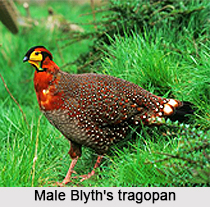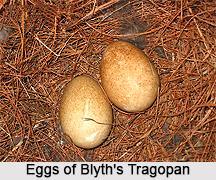 Blyth"s tragopan is an Indian bird with a scientific name "Tragopan blythii" or the grey-bellied tragopan.
Blyth"s tragopan is an Indian bird with a scientific name "Tragopan blythii" or the grey-bellied tragopan.
History of Blyth"s tragopan
Blyth"s tragopan is a pheasant that is a vulnerable species. The common name commemorates Edward Blyth (1810-1873), English zoologist and Curator of the Museum of the Asiatic Society of Bengal.
Population of Blyth"s tragopan
The population of the animal is small and is believed to be decreasing at a rapid rate. Blyth"s tragopan is located in many different areas, including Bhutan through north-east India, north Myanmar to south-east Tibet, and also China. The total population is estimated to be about 2,500 to 9,999 birds. This estimate is a very small in number compared to some of its relative birds.
Habitat of Blyth"s tragopan
 Blyth"s tragopan normally flocks to wooded areas as it prefers the undergrowth of evergreen oak and rhododendron forests, and other dark, quiet places. This bird has a higher elevation than most birds.
Blyth"s tragopan normally flocks to wooded areas as it prefers the undergrowth of evergreen oak and rhododendron forests, and other dark, quiet places. This bird has a higher elevation than most birds.
Structure of Blyth"s tragopan
Blyth"s tragopan pheasant is the largest of the genus Tragopan. Like most pheasants, the male is brightly coloured. It is recognized by its rusty red head, yellow facial skin, and that it is spotted with small white dots on its back called ocelli. A black band extends from the base of the bill to the crown coupled with another black band extending behind the eyes. Like the rest of the tragopans, males have two pale blue horns that become erect during matting. Its lappet, a decorated flap, hangs from the throat and is brightly coloured. This lappet can be expanded and exposed during mating season as well. Females are not as brightly coloured as the male tragopan, for they do not need the extravagant appearance to attract a male counterpart. Overall, they are dark brown with a mixture of black, buff and white mottling. Their simple and dull look is a protection mechanism from other animals, known as camouflage. It also allows the females to protect their young that are in the early stages of life.
Food Consuming by Blyth"s tragopan
Blyth"s tragopans are generalists in nature. In the wild, they consume seeds, berries, fruits, and buds. The captive birds usually consume insects, worms, and even small frogs. While they are primarily vegetarians, most birds have a predilection for berries and fruit.
 The bird primarily moves up and down the slopes in search for food. It is, however, uncommon for this species to travel far, due to the change in climate from area to area. This is a result of the mild winters in their habitat, which is tolerable for longer periods of time. For the majority of the species, travel is only necessary in attempting to avoid the drying out of their vegetation. In this case, they may move down mountain sides for more comfortable living conditions and a readier food supply.
The bird primarily moves up and down the slopes in search for food. It is, however, uncommon for this species to travel far, due to the change in climate from area to area. This is a result of the mild winters in their habitat, which is tolerable for longer periods of time. For the majority of the species, travel is only necessary in attempting to avoid the drying out of their vegetation. In this case, they may move down mountain sides for more comfortable living conditions and a readier food supply.
Mating of Blyth"s tragopan
Blyth"s tragopan starts mating in April and continues well into May. The males advertise themselves with flamboyant displays to attract females.
Courtship of Blyth"s tragopan
The mating display of Blyth"s tragopan involve bowing and scraping the ground with their wings slightly raised and their flesh horns fully dilated while projected forward. The more flamboyant and extravagant the male acts are, the more likely they are to attract a female. If the female does not respond, the male intensifies this wild behaviour to draw more attention to him. The male then proceeds to strut around the female, in an attempt to distract the female. He then continues the movements with his breast pushed forward and his wings extended into the air.











